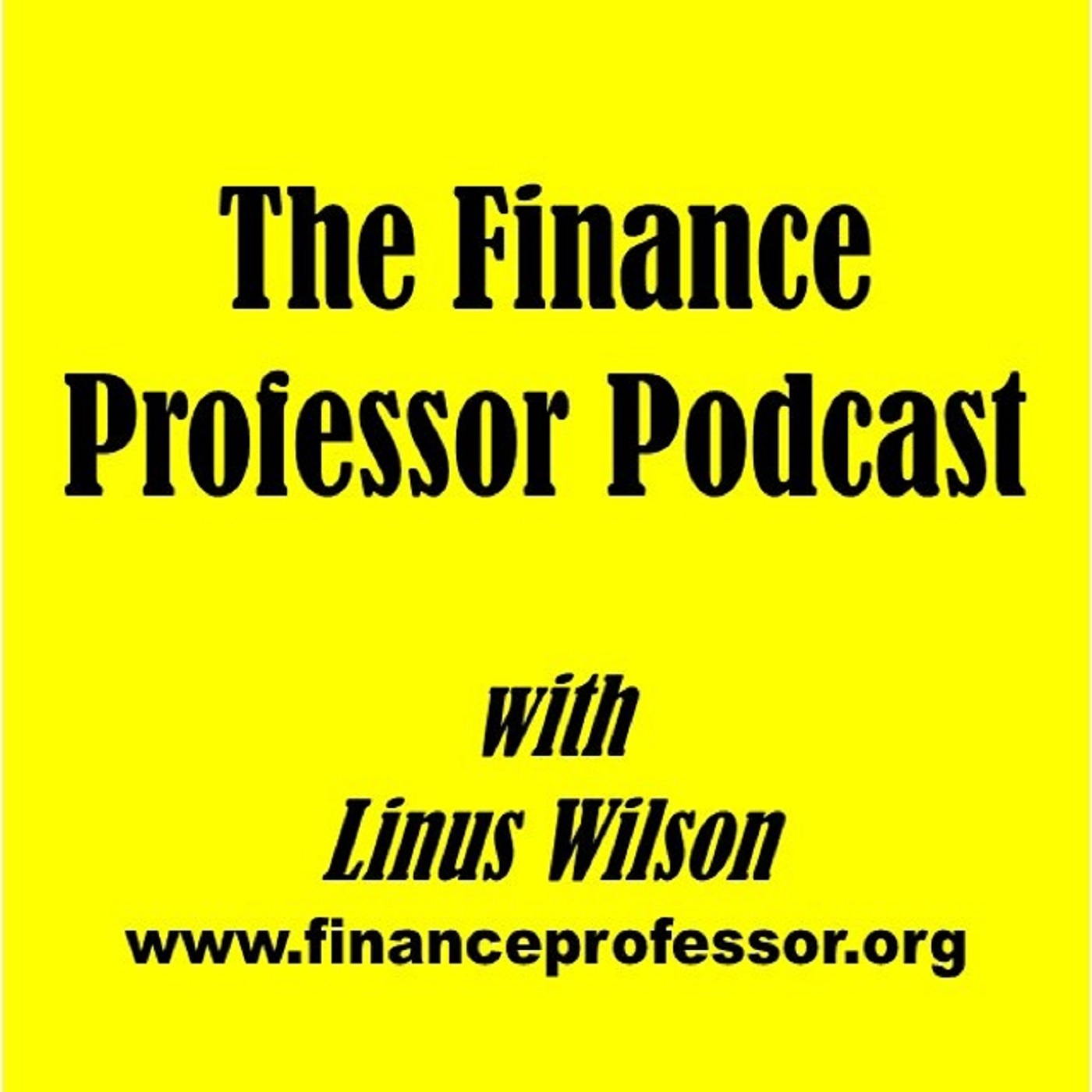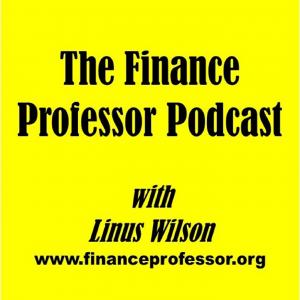
3.3K
Downloads
20
Episodes
The Finance Professor Podcast is hosted by Linus Wilson. Dr. Wilson earned his Ph.D. in 2007 from Oxford University. He has taught thousands of finance students at all levels. His research is in banking, financial crises, CEO pay, and corporate finance. He has been a source for over two hundred major news stories in the Wall Street Journal, New York Times, Financial Times, and other news organizations. He is a leading scholar on the TARP bank bailouts of the great recession.
Episodes

Sunday Apr 19, 2020
Sunday Apr 19, 2020
Dr. Wilson reads and discusses his new paper:
Wilson, Linus, Estimating the Life Expectancy and Value of Statistical Life (VSL) Losses from COVID-19 Infections in the United States (April 19, 2020). Available at SSRN: https://ssrn.com/abstract=3580414
His the "Download this paper" button to get a free copy.
Estimating the Life Expectancy and Value of Statistical Life (VSL) Losses from COVID-19 Infections in the United States
By
Dr. Linus Wilson
Associate Professor of Finance
Department of Economics & Finance
B.I. Moody III College of Business
University of Louisiana at Lafayette
Theses are the views of the author alone.
"
Abstract
Americans aged sixty or older stand to lose 153 to 222 days of life expectancy from contracting COVID-19. Over 90 percent of the U.S. population was under stay at home orders by April 2020. These social distancing measures to slow the spread of the SARS-CoV-2 or novel coronavirus have led to over 20 million new applications for unemployment benefits. Are these economic losses justified? We find the value of statistical lives lost (VSL) from an unconstrained spread of the virus which hypothetically infected 81 percent of the population would amount to $8 to $60 trillion.
Journal of Economic Literature Codes: G22, I1, I18, J31, J65, K32
Keywords: actuarial tables, mortality, death rates, CFR, COVID-19, IFR, life expectancy, SARS-CoV-2, school closures, social distancing, stay at home orders, VSL
1. Introduction
This paper attempts to open the discussion of how to model the benefits of social distancing measures in terms of the value of statistical lives (VSL) saved in the SARS-CoV-2 or COVID-19 pandemic. To do this we compare the infection fatality rates IFR’s of Ferguson et al. (2020) to the VSL from several studies. We find in figure 3 panels A and B that the costs of 50 percent of the U.S. population being infected with COVID-19 in lives lost and VSL are, respectively, between 0.659 million and 2.305 million lives lost and between $5 trillion and $37 trillion in VSL losses. The Gross Domestic Product (GDP) was only $21.7 trillion at the end of 2019 according to Mataloni and Aversa (2020).
We use U.S. Census data to control for the age and gender of the population and show how a COVID-19 infection affects an individual’s life expectancy and compares to a typical year’s mortality. Life expectancy losses of between 153 and 222 days can be expected for Americans over 60 with a novel coronavirus infection, according to figure 2, panel C. Americans younger than forty can expect to lose less than two weeks of life expectancy from contracting the virus. In figure 1, panel C, persons over fifty can expect COVID-19 to be about as deadly or up to 70 percent more deadly than a year’s mortality risks. Persons younger than forty-years-old can expect less than half a year’s mortality risk in a COVID-19 infection.
To argue against the social distancing measures, either the IFR of COVID-19 must be nearer to the low end of Ferguson et al. (2020)’s 95 percent confidence interval or the social distancing measure must be very ineffective in reducing the reproductive number, R0, of the SARS-CoV-2 virus. As to the former, a few studies suggest a much lower mean IFR than the 0.9 percent from Ferguson et al. (2020). Ioannidis (2020) argues that, after adjusting for the age of the infected on the Diamond Princess cruise ship, the IFR for the U.S. population should be 0.3 percent, which is below the lower bound of the 95 percent confidence interval calculated in Ferguson et al. (2020) and used here. Likewise, a population-weighted study, Bendavid et al. (2020), recruited people to be tested in Santa Clara County, California regardless of symptoms for COVID-19. It found infection rates were severely under-reported. They calculated an IFR between 0.12 and 0.2 percent.
On the other hand, social distancing may be effective in reducing the spread of COVID-19. R0 is the number of additional persons that an infected person goes on to infect on average. Anecdotal evidence indicates that social distancing in late March and early April 2020 has been effective. Governor Andrew Cuomo of New York State, which has had the highest number of deaths and confirmed cases of COVID-19 of the U.S. states on April 16, 2020, argued in his daily briefing in CNBC (2020) that his modeling teams believed that R0 fell from a median of 2.5 in Wuhan before social distancing and 2.2 on the Diamond Princess Cruise ship to 0.9 in New York State after the mitigation efforts. Governor Cuomo argued that his advisors’ projected hospitals in the state would be overwhelmed with COVID-19 patients if R0 was persistently above 1.2.[1] Rocklöv et al. (2020) estimate that uncontrolled R0 for COVID-19 on the Diamond Princess cruise ship was 14.8 before social isolation and 1.8 afterward. Chowell et al. (2011) argued that school closures in Mexico reduced the R0 of the H1N1 outbreak by more than 30 percent.
This paper will not attempt to measure the costs of social distancing which, no doubt, number in the many trillions of dollars in the United States alone. By April 7, 2020, Secon and Woodward (2020) reported that 95 percent of the U.S. population was under a stay at home order that meant all but “essential” businesses were shuddered. Morath and Chaney (2020) report that by April 16, 2020, 13 percent of the U.S. workforce or 22 million workers had filed unemployment insurance claims. The COVID-19 multi-state stay at home orders, and associated non-essential business shutdowns, began with California, on March 19, 2020, according to Mervosh et al. (2020). Before the SARS-CoV-2 disruptions, the U.S. unemployment rate stood at a record low 3.5 percent in February 2020 according to the Bureau of Labor Statistics.
Eichenbaum et al. (2020) estimate containing COVID-19 “optimally” with social distancing will lead to consumption dropping by 22 percent versus 7 percent without containment of the virus. Since consumption is about 68.1 percent of GDP, according to the St. Louis Fed, and 2019 GDP was $21.7 trillion, they are arguing macroeconomic consumption losses are about (0.22 – .07)*$21.7 trillion = $3.26 trillion. The loss of freedom cannot just be measured in just macroeconomic statistics. Aggregate consumption does not measure the loss of consumer and producer surplus. There may also be long-term effects to school-age children or households facing bankruptcy that may not be captured fully in Eichenbaum et al. (2020). People losing their jobs also lose their health insurance and may be more likely to die as a result. Certainly, more empirical work can be done to estimate the actual costs of social distancing measures relative to their R0 benefits.
One press release, Yale News (2020), from the Yale Tobin Center for Economic Policy estimated the daily losses of shutdowns at $19 billion per day or about $7 trillion per year. Nevertheless, $3 to $7 trillion annually is less than this paper’s low-end estimates of the VSL losses for anything resembling the unconstrained spread of the virus infecting 81 percent of the population that Ferguson et. al (2020) project. Our low-end VSL losses are $8 trillion for an 81 percent infection rate. For the high-end estimate, the value of statistical lives lost is about $60 trillion.
Overall, the results of this paper point to sizable personal risks for individuals over sixty becoming infected with COVID-19 in terms of the increased chance of death and reduced life expectancy. We also find that the number of deaths and value of statistical life (VSL) losses are extremely high from high rates of COVID-19 infection. Thus, major economic disruptions from social distancing, stay at home orders, and school closures will be justified if the infection fatality rate estimates are reasonable. Measurement error of IFR, pharmaceutical treatments reducing the fatality rates, or a vaccine could make social distancing economic disruptions not worth the cost.
[1] See the discussion around the 24:45 minute mark of CNBC (2020)."

No comments yet. Be the first to say something!